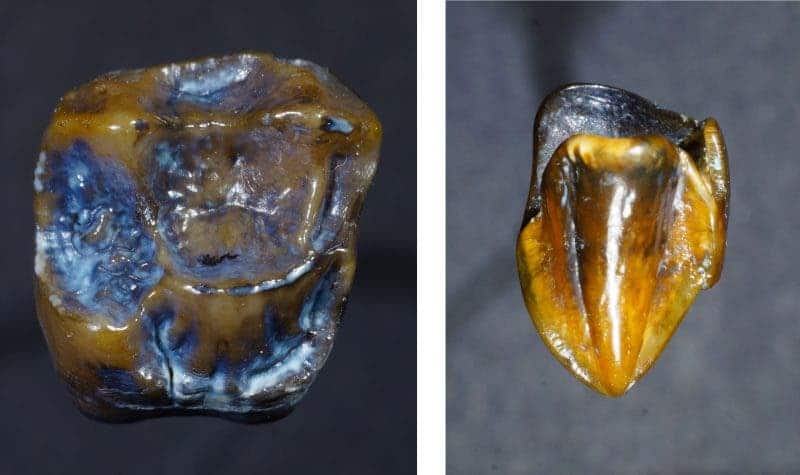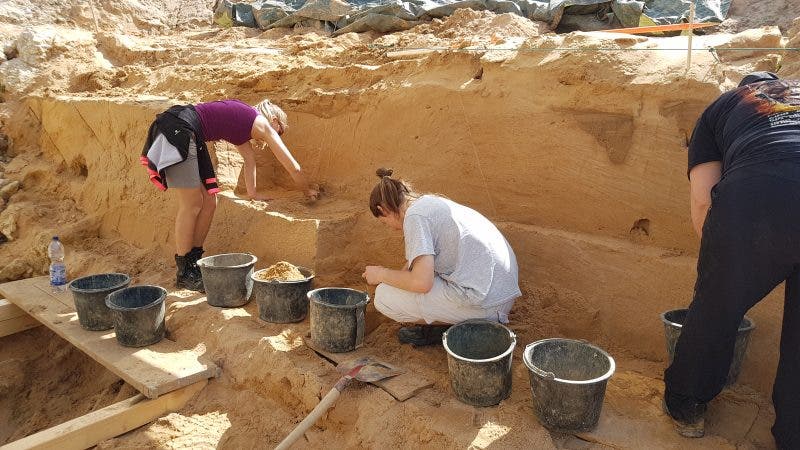
In a former riverbed of the Rhine, near the town of Eppelsheim, a region famous for a treasure trove of fossils, German scientists found two fossilized teeth with contradictory features. The molar and left canine belonging to the same individual are nearly ten million years old and bear a resemblance to hominin species such as Australopithecus afarensis. The conundrum lies in the fact that A. afarensis is no more than 3 million years old and no human ancestor was found in Europe earlier than 100,000 years ago. This puts the entire debate under a whole new light.
The real planet of the apes
The findings were made in 2016 but the team led by Herbert Lutz, a paleontologist at the Mainz Natural History Museum in Germany, delayed publishing due to the controversial nature of the two fossilized teeth. What’s certain, says Lutz, is that the teeth dated to 9.7 million years ago belong to a primate and signify “the northernmost occurrences of Miocene primates in Europe.”
“Both teeth, the crowns of an upper left canine and an upper right first molar, are exceptionally well preserved and obviously come from the same body of unknown sex. Their sedimentological environment and the accompanying faunal elements point to an age shortly before the Mid-Vallesian crisis at ca. 9.7 Ma. While the molar shares characters with various other taxa, the canine reveals intriguingly potential hominin affinities: its lingual outline is clearly diamond-shaped; its ratio of lingual height / mesiodistal length is within the range of Australopithecus afarensis, Ardipithecus ramidus, Ardipithecus kadabba, and females of Pan troglodytes,” the authors reported in a paper, which appeared in pre-print.
In the aftermath of the discovery, some have haphazardly painted this whole event into something far more spectacular than it really is, which in reality, is just ambiguous at this point. For instance, during a press conference announcing the discovery, the mayor of Mainz said he doesn’t want to “over-dramatize it” but “we shall have to start rewriting the history of mankind after today.” One can only wonder what the fine mayor’s view of overly dramatic looks like in this case.

Scientists are, of course, far more reserved. Despite the resemblances to hominin groups, it’s far likelier, as Lutz and colleagues themselves reported, that the molar and canine belong to a broader group called hominoids. In other words, “apes”.
As far back as 12 million years ago, Europe was a sort of an ape paradise. There’s no doubt that apes originated in Africa, or that our more recent evolution happened there, but up to eight million years ago they also flourished in Europe around the Mediterranean when climate change forced these populations to gradually disappear.
One of these apes was Oreopithecus, first unearthed in the 19th century in Italy. Though it does not belong to our branch of the ape evolutionary tree, Oreopithecus, one of the last surviving species from this ‘golden age’ of European apes, oddly looked a lot like an early member of our lineage. Perhaps, Eurasian primate bearing these teeth and its distant African relatives encountered similar environmental pressure, independently leading to very similar tooth configurations. There are many examples of convergent evolution, after all.
Maybe it’s not even an ape
The isolated discovery of two teeth, which are far less interesting than most other body parts such as a femur or skull, can’t “rewrite history”. However, it’s fascinating that ancient apes could have lived this far north in Europe, but speculating any further is just thoughtless sensationalism. What’s more, the fossils might not even belong to an ape.
Speaking to National Geographic, Bence Viola, who is a paleoanthropologist at the University of Toronto and an authority on the teeth of extinct human relatives, says the fossils likely belong to some pliopithecoid species — an extinct superfamily of catarrhine primates that inhabited Asia and Europe during the Miocene. Pliopithecoids are very far away, evolutionary speaking, from humans, having diverged from the common ancestors of Old World monkeys and apes long before the two branches split.
“I think this is much ado about nothing,” Viola said. “The second tooth (the molar), which they say clearly comes from the same individual, is absolutely not a hominin, [and] I would say also not a hominoid.”
In other words, the teeth might belong to some primate species which is less related to modern humans than a baboon. However, the German scientists are still working on their paper, so the last word may yet to come.
“Hopefully, in one or two years, we’ll know a lot more about what we’ve got on our hands,” Lutz told ResearchGate. “It’s definitely a fantastic, exciting story.”






